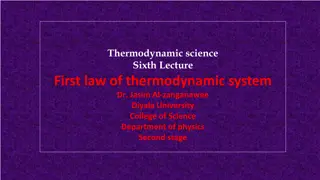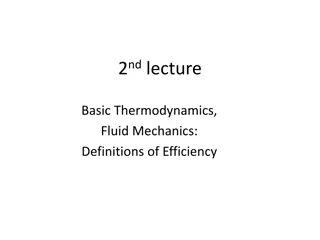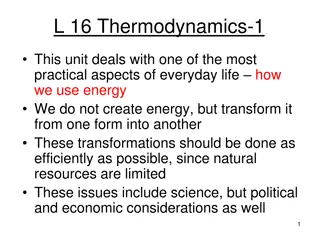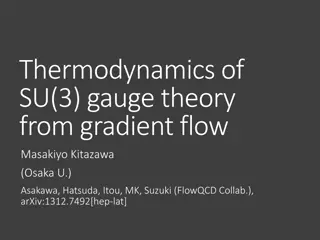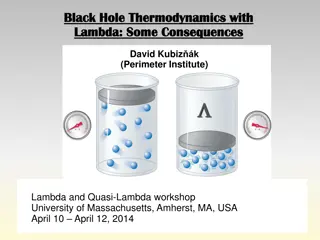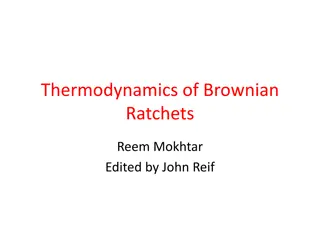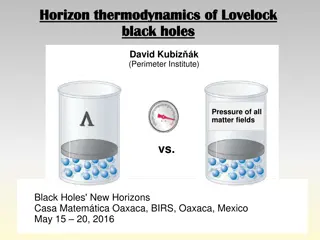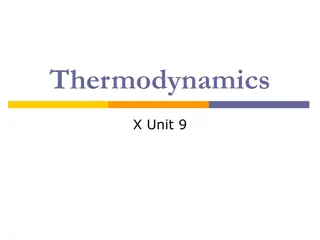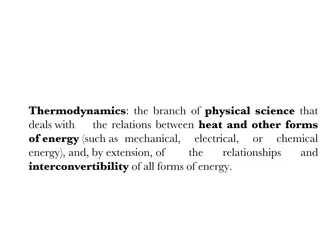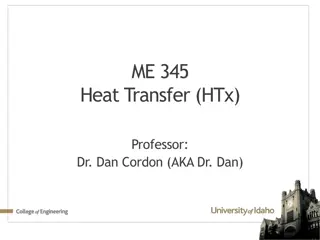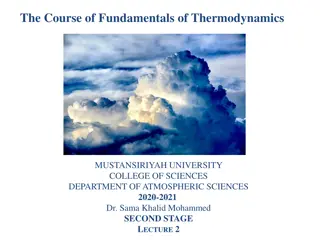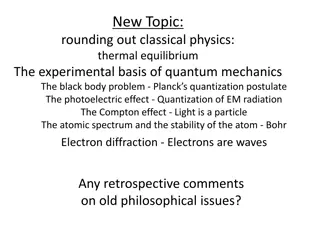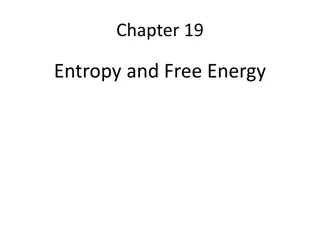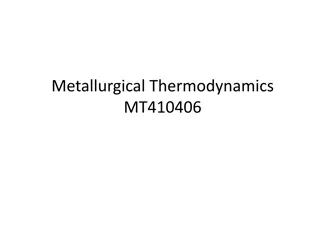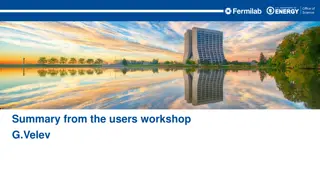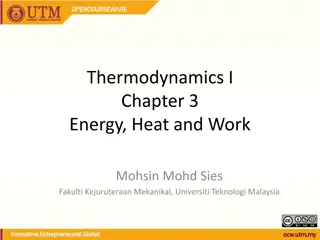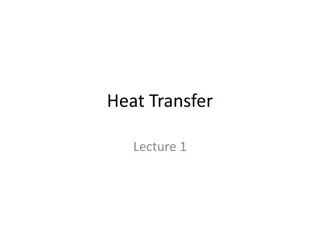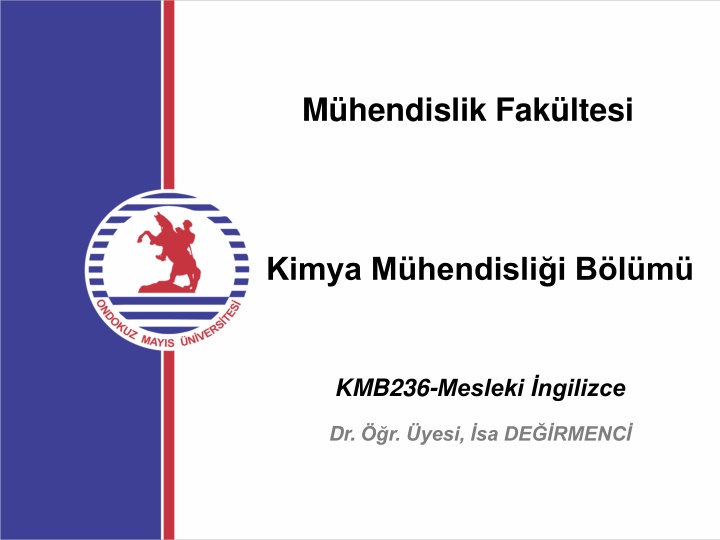
Thermodynamics and Energy Concepts
This content covers essential topics in thermodynamics and energy, including thermochemistry, laws of thermodynamics, energy terminology, kinetic and potential energy, energy and temperature relationships, thermodynamic systems, and the zeroth and first laws of thermodynamics. It explores the behavior of heat, temperature, energy, and work in various systems, emphasizing the conservation and transformation of energy forms.
Download Presentation

Please find below an Image/Link to download the presentation.
The content on the website is provided AS IS for your information and personal use only. It may not be sold, licensed, or shared on other websites without obtaining consent from the author. If you encounter any issues during the download, it is possible that the publisher has removed the file from their server.
You are allowed to download the files provided on this website for personal or commercial use, subject to the condition that they are used lawfully. All files are the property of their respective owners.
The content on the website is provided AS IS for your information and personal use only. It may not be sold, licensed, or shared on other websites without obtaining consent from the author.
E N D
Presentation Transcript
Mhendislik Fakltesi Kimya M hendisli i B l m KMB236-Mesleki ngilizce Dr. r. yesi, sa DE RMENC
Thermochemistry KMB236-Mesleki ngilizce Hafta-7
Thermodynamics Thermodynamics is a branch of science concerned with heat and temperature and their relation to energy and work. The behavior of these quantities is governed by the four laws of thermodynamics.
Laws of thermodynamics Zeroth law of thermodynamics First law of thermodynamics Second law of thermodynamics Third law of thermodynamics
Terminology Energy, U The capacity to do work. Work Force acting through a distance.
Energy Kinetic Energy The energy of motion. Potential Energy Energy due to condition, position, or composition. Associated with forces of attraction or repulsion between objects. Energy can change from potential to kinetic.
Energy and Temperature Thermal Energy Interms of thermal energy we consider kinetic energy and temperature. Kinetic energy associated with random molecular motion. In general, thermal energy is proportional to temperature. And it is an intensive property. Heat and Work Heat is represented by a letter q and work is represented by a letter w. Both provide us mesurament of changes of energy during a change of a system state.
Thermodynamic Systems
Zeroth law of thermodynamics The zeroth law of thermodynamics states that if two thermodynamic systems are each in thermal equilibrium with a third, then they are in thermal equilibrium with each other.
First law of thermodynamics The law of conservation of energy This states that energy can be neither created nor destroyed. However, energy can change forms, and energy can flow from one place to another. A particular consequence of the law of conservation of energy is that the total energy of an isolated system does not change.
First Law of Thermodynamics A system contains only internal energy. A system does not contain heat or work. These only occur during a change in the system. U = q + w Law of Conservation of Energy The energy of an isolated system is constant
For the closed system, if the energy entering the system is supplied as heat and energy leaves the system as work U = Q + W
Conservation of Energy In interactions between a system and its surroundings the total energy remains constant energy is neither created nor destroyed. qsystem+ qsurroundings= 0 qsystem= -qsurroundings Law of conservation of energy
Heat Energy transferred between a system and its surroundings as a result of a temperature difference. Heat flows from hotter to colder. Temperature may change. Phase may change (an isothermal process).
Units of Heat Calorie (cal) The quantity of heat required to change the temperature of one gram of water by one degree Celsius. Joule (J) SI unit for heat 1 cal = 4.184 J
Heat Capacity The quantity of heat required to change the temperature of a system by one degree. Molar heat capacity. System is one mole of substance. Specific heat capacity, c. System is one gram of substance Heat capacity Mass x specific heat. q = mc T q = C T
Heats of Reaction Chemical energy. Contributes to the internal energy of a system. Heat of reaction, qrxn. The quantity of heat exchanged between a system and its surroundings when a chemical reaction occurs within the system, at constant temperature.
Heats of Reaction Exothermic reactions. Produces heat, qrxn< 0. Endothermic reactions. Consumes heat, qrxn> 0. Calorimeter A device for measuring quantities of heat. Heat of reaction in an isolated system produces a change in the thermal energy of the system. The causes a temperature change. In an non-isolated system the temperature remains constant and the heat is transferred to the surroundings. Top picture is CaO(s) + H2O(l) Ca(OH)2 Bottome picture is Ba(OH)2 8H2O + 2NH4Cl(s) BaCl2(s) + 2 NH3(aq) + 8 H2O(l)
Example Using Bomb Calorimetry Data to Determine a Heat of Reaction. The combustion of 1.010 g sucrose, in a bomb calorimeter, causes the temperature to rise from 24.92 to 28.33 C. The heat capacity of the calorimeter is 4.90 kJ/ C. What is the heat of combustion of sucrose, expressed in kJ/mol C12H22O11 (5643 kJ/mol, 342,30 g/mol) Verify the claim of sugar producers that one teaspoon of sugar (about 4.8 g) contains only 19 kilo calories.
Coffee Cup Calorimeter A simple calorimeter. Well insulated and therefore isolated. Measure temperature change. qrxn= -qcal
In addition to heat effects chemical reactions may also do work. Gas formed pushes against the atmosphere. Volume changes. Pressure x volume change = work
Pressure Volume Work w = F x d = (P x A) x h = P V w = -Pext V Negative sign is introduced for Pextbecause the system does work ON the surroundings. When a gas expands V is positive and w is negative. When a gas is compressed V is negative and w is positive, indicating that energy (as work) enters the system. In many cases the external pressure is the same as the internal pressure of the system, so Pextis often just represented as P
Quote of the week The Only Thing That Is Constant Is Change Heraclitus

